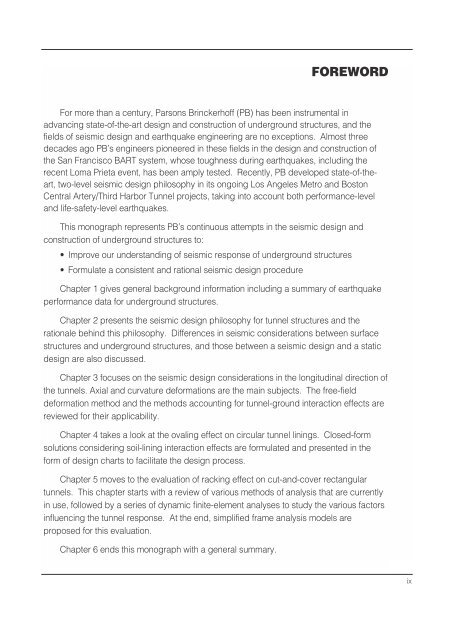Seismic Design of Tunnels - Parsons Brinckerhoff
Seismic Design of Tunnels - Parsons Brinckerhoff
Seismic Design of Tunnels - Parsons Brinckerhoff
Create successful ePaper yourself
Turn your PDF publications into a flip-book with our unique Google optimized e-Paper software.
FOREWORD<br />
For more than a century, <strong>Parsons</strong> Brinckerh<strong>of</strong>f (PB) has been instrumental in<br />
advancing state-<strong>of</strong>-the-art design and construction <strong>of</strong> underground structures, and the<br />
fields <strong>of</strong> seismic design and earthquake engineering are no exceptions. Almost three<br />
decades ago PB’s engineers pioneered in these fields in the design and construction <strong>of</strong><br />
the San Francisco BART system, whose toughness during earthquakes, including the<br />
recent Loma Prieta event, has been amply tested. Recently, PB developed state-<strong>of</strong>-theart,<br />
two-level seismic design philosophy in its ongoing Los Angeles Metro and Boston<br />
Central Artery/Third Harbor Tunnel projects, taking into account both performance-level<br />
and life-safety-level earthquakes.<br />
This monograph represents PB’s continuous attempts in the seismic design and<br />
construction <strong>of</strong> underground structures to:<br />
• Improve our understanding <strong>of</strong> seismic response <strong>of</strong> underground structures<br />
• Formulate a consistent and rational seismic design procedure<br />
Chapter 1 gives general background information including a summary <strong>of</strong> earthquake<br />
performance data for underground structures.<br />
Chapter 2 presents the seismic design philosophy for tunnel structures and the<br />
rationale behind this philosophy. Differences in seismic considerations between surface<br />
structures and underground structures, and those between a seismic design and a static<br />
design are also discussed.<br />
Chapter 3 focuses on the seismic design considerations in the longitudinal direction <strong>of</strong><br />
the tunnels. Axial and curvature deformations are the main subjects. The free-field<br />
deformation method and the methods accounting for tunnel-ground interaction effects are<br />
reviewed for their applicability.<br />
Chapter 4 takes a look at the ovaling effect on circular tunnel linings. Closed-form<br />
solutions considering soil-lining interaction effects are formulated and presented in the<br />
form <strong>of</strong> design charts to facilitate the design process.<br />
Chapter 5 moves to the evaluation <strong>of</strong> racking effect on cut-and-cover rectangular<br />
tunnels. This chapter starts with a review <strong>of</strong> various methods <strong>of</strong> analysis that are currently<br />
in use, followed by a series <strong>of</strong> dynamic finite-element analyses to study the various factors<br />
influencing the tunnel response. At the end, simplified frame analysis models are<br />
proposed for this evaluation.<br />
Chapter 6 ends this monograph with a general summary.<br />
ix
















